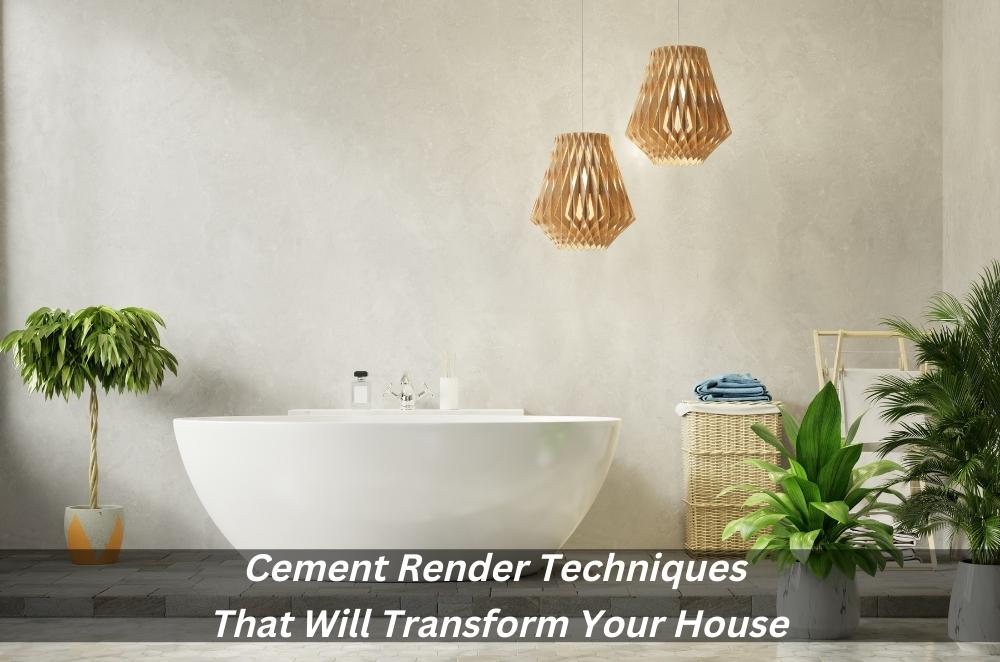Cement render has become one of the most useful techniques in the construction industry. This technique allows us to create beautiful designs using cement. The process involves mixing liquid concrete and dry cement together before pouring them into forms.
These materials come from two separate buckets and are then mixed together in between the forms. The resulting mixture sets and hardens within hours.
This method is great for creating architectural features such as columns or decorative details. It is also suitable for outdoor projects because it does not require additional finishing.
For example, it makes excellent patio pavers and walkways. Most importantly, this type of render is a very affordable option that can save you time and money.
Here are some examples of how this technique works:
- Columns & Decorative Elements: You can use cement render to create simple columns or intricate elements with complex shapes. To make a column, pour wet concrete into a form and let it set. Then, cut off the excess material and smooth out any rough surfaces.
- Pavers: If you want to cover a large surface area, cement rendering is an ideal choice. First, pour wet concrete into forms and wait for it to dry. When it’s fully cured, remove all excess material and smooth cement renders out rough areas.
Mix another batch of sand and cement render with water to achieve the desired colour. Let it cure again and repeat the process until the entire surface looks finished.
- Patios & Walkways: Pour cement render over any kind of porous material, like gravel, brick or stone. Smooth out any rough edges once it has hardened. Now, if you don’t mind the extra work, you can apply mortar to fill in small gaps and joints.
Otherwise, just let it be! Because cement render doesn’t require additional finishing, it will last forever.
- Driveways: Add stones, gravel or other porous surfaces to create an attractive driveway. Then, pour cement render over the top. Repeat the above steps until you get the desired look and feel.
- Stairs: Another major advantage of cement render over the brick is its ability to withstand moisture. Because of this, we often use it to build stairs. Here’s what you need to know about building staircases with cement render:
- Brickwork & Fireplaces: Since cement render is more durable than bricks, it can also be used to replace old bricks when building fireplaces. For small projects, we usually use cement render to cover the joints between bricks:
- Exterior Wall Features: If you want to add some colour to your home’s external walls, consider adding tiles to your roof instead of installing brick. This way, you will enjoy a much cheaper alternative.
Cement render brick wall isn’t necessarily limited to outdoor applications either. As mentioned earlier, we’re able to create unique feature walls such as columns or ornamental details indoors.
- Pool Decking: With cement render, you don’t need to worry about maintenance or fading like traditional decking. Unlike wood boards, it doesn’t absorb stains easily so it looks good even after years of exposure. Also, once it dries, it becomes waterproof.
- Showers & Bathrooms: If you want to install tile around your bathroom or shower, cement render types are a perfect choice. After setting, you won’t have to worry about cleaning up grout lines.
- Landscaping: When planning landscaping, consider using cement render to line paths or borders. It provides a clean transition from one garden wall to the next.
- Roofing: While ceramic tiles are commonly used, they tend to fall off roofs if not properly installed. Therefore, if you’re looking for something that lasts, this render type might be the best option for you.
- Exterior Walls & Internal Walls: It is great for creating decorative walls inside your home. You may choose any pattern to match the overall style of your room.
Cement Rendering Cost
Cement rendering cost refers to the amount that should be charged for preparing a concrete structure for use in a building or any project. This includes both the labour costs associated with cutting and placing blocks and mortar, as well as the materials used to render them.
The price depends largely upon the quantity of work involved and the quality of construction required. Generally speaking, a higher-quality job requires more expensive materials (such as natural stone), whereas lower-quality jobs require less costly materials (such as sand).
In addition, there are additional factors to consider when estimating the cost of it. These include the type of project that needs to be completed, the size of the area being rendered, the type of cement used, how many coats are needed throughout the entire job and the amount of time taken to complete the project.
When considering these various factors, it’s important to remember that the final cost of a job can vary considerably depending on the specific circumstances of each individual case. To determine the approximate cost of your project, simply multiply the total number of square feet by $30 per square foot.
Depending on where you live, you might be able to get away with paying between $30 and $80 per square foot for renderings. However, this estimate does not take into account any special charges that may apply based on local standards and regulations.












